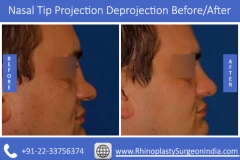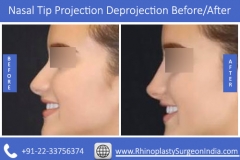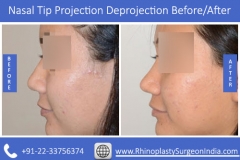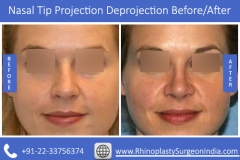Nasal Tip Projection & Deprojection
The nose is the central part of the face and without any doubt plays the most important part in defining facial aesthetics. Nasal tip projection and deprojection also play an important role in overall facial proportions. The tip projection has to be assessed carefully concerning the face and the nasal dorsum to give it a balanced appearance. Rhinoplasty is the procedure that is used to increase, maintain, or decrease the projection of the nasal tip. Nasal tip projection and deprojection is also associated with the nasal tip rotation and the length of this ideal nose. Therefore any changes in the projection of the nose have to be carefully worked out before the surgery and the method to be chosen carefully.
Nasal tip projection can be assessed on the basis of two factors one is the nasal tip rotation which is measured in terms of the nasolabial angle. For men, the angle is between 90 to 105 degrees and for women this ideal angle should be 90 to 120 degrees. The second factor is the tip projection which is the distance between the alar groove and the tip defining point. Several features of the anatomy of the nose can determine nasal tip projection and deprojection. These include the type of skin, the shape size, and strength of the rib cartilages rhinoplasty, the length of the crura, the length of the columella, and the nasal spine. In most of the cases of Rhinoplasty for nasal tip rotation because of projection and deprojection of the nasal tip the surgeon will be able to determine the fault by looking at the profile view.
Nasal Tip Projection
Nasal tip projection is cause of concern because it can cause obstruction to the airway. There can be many causes for the tip projections deviation from the idea for the face.
The over-projected tip is caused because of
- Excess alar cartilage
- Overdevelopment of the nasal spine
- Excess caudal septal and dorsal septal
- Elongated columella and medial crura
- A combination of all the above
The under-projected nasal tip can be because of
- Small alar plasty
- Small nostrils
- Short columella
- Illusion of underprojection also appears when the nasofacial angle is reduced
- Maxillary retrusion
Nasal tip deprojection
Deprojection is one of the most uncommon procedures among all Rhinoplasty procedures. For the nasal tip that is over projected deprojection and Rhinoplasty become necessary. This brings the nose closer to the face. Aim of the Rhinoplasty is to maintain the proportion between the nose and the face. For deprojection, the normal cartilage (which is the highest point of the lower lateral cartilage), is brought down. There are two methods used for deprojection of the nasal tip one is to reduce the nasal bridge height and the other is to detach the lower lateral cartilage reshape it, move it, and reattach it. Both options can be done using open Rhinoplasty or closed Rhinoplasty approach. In most the cases, the nasal tip rotation is also done in order to balance the aesthetics of the face. Tip rotation is calculated on the basis of the amount of tip deprojection.
Nasal tip projection
Nasal tip projection rhinoplasty is a complex rhinoplasty procedure because it involves increasing the existing structure and modifying it in such a way that it appears natural and is long-sustaining. There are a number of procedures used for nasal tip projection. The selection of the procedure depends on the surgeon’s evaluation of the nasal tip and the tip rotation required. The techniques include placing grafts to increase the length of the columella, and modifying the length of the height of the alar cartilage using sutures. The tripod structure of the base of the nose (nostrils and tip) has to be kept in mind when working with the tip projection.
Any changes (projection and deprojection) of the nasal tip are done with the consideration in mind that the overlying skin and soft tissue have different limitations for different persons. Therefore, their strength has to be kept in mind by the expert surgeon.
Nasal Tip Projection & Deprojection Before After Photos, See the Patient Results-
Frequently Asked Questions for Nasal Tip Projection & Deprojection –
Question 1: What is Tip Projection after Rhinoplasty?
The projection of the nasal tip describes how much the tip sticks out from the face when viewed from the side or a profile.
Question 2: How Long After Rhinoplasty Will the Tip Drop?
Over the following six weeks after rhinoplasty, your tip should get smaller as the swelling goes down and the wounds close. However, it may take up to a year to fully appreciate the results of your nose surgery.
Question 3: Can I Touch my Nose 10 Days after Rhinoplasty?
For at least one to two weeks following surgery, patients should take great care to refrain from applying any pressure to their nose, including even touching it.
Reference Link –
- https://www.ncbi.nlm.nih.gov/pmc/articles/PMC2940967/
- https://emedicine.medscape.com/article/840646-overview
- https://www.healthline.com/health/upturned-nose






